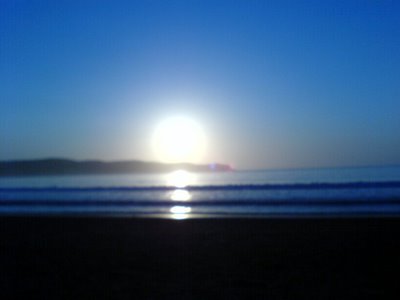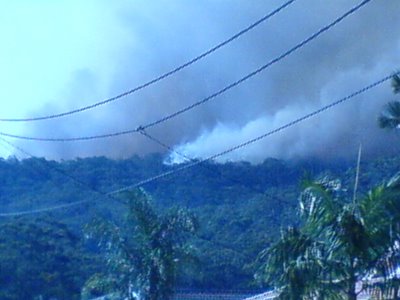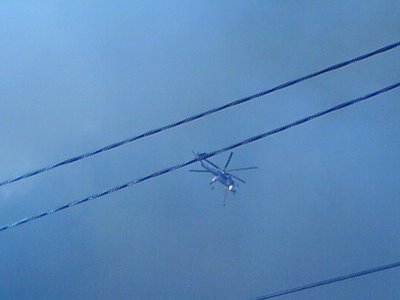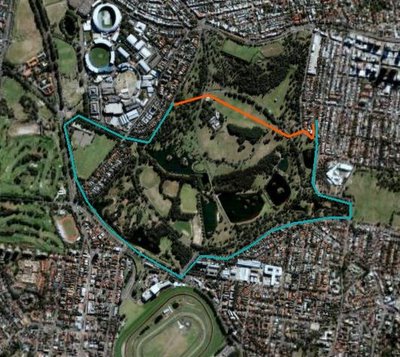26th December, 2005
After a great Xmas day spent with my wife, kids and family at my Mum's house in Double Bay, I managed to rise early and head down to Bondi Beach at 7.00am to run off some of that excess food and red wine.

The humidity was so high and you could cut the air with a knife. The sea fog rolled in and visibility was bugger all. The shot above is from the sand north to Ben Buckler.
I ran strong for about 60:00 and finished without any sign of shin soreness. I decided then to continue running either every day or second day of my time off on the soft sand as an attempt to eliminate my shin problem altogether.
30 December, 2005
For the past couple of years we have been spending a week of our break including NYE with my Dad and his wife at their house in Umina Beach. My Dad is 70 this year and I really enjoy getting quality time with him as do the kids. I've been running everyday and feeling really strong.

Dad only lives 400m from the southern end of Umina Beach, so my run starts from there and includes Ocean Beach and Ettalong Beach, which is about 9km out and back. All my runs are done early in the mornings and I'm feeling great and injury free.
 Sunrise at Umina Beach
Sunrise at Umina Beach
 Lion Island with Barrenjoey light house (Palm Beach) in the background
1st January, 2006
Lion Island with Barrenjoey light house (Palm Beach) in the background
1st January, 2006
We celebrated the New Year with a few of Dad's neighbor's and had a nice barbie and a few beers. I managed to drag myself out of bed early and headed out for a run. At 8.00am it was 34 degrees. Needless to say I lugged my badly dehydrated body up and down the beach with a fair degree of pain. However in memory of the Fat Ass runners down at Berowra, I had no real excuse but to slog it out.
 The new years revellers were up to mischief and had the surf club at Ocean Beach up for sale. LOL.
The new years revellers were up to mischief and had the surf club at Ocean Beach up for sale. LOL.
After breakfast we spent the morning at the beach. By about 11.00am it was about 44 degrees and the beach was waaaay to hot to stay any longer, so we headed back for lunch. Walking back we noticed a plume of smoke coming from the ridge behind the house. By about 4.00pm the whole ridge was on fire and we had 7 choppers in the sky dumping water on the flames. We were told that 20 trucks and up to 100 men were on the ground protecting property.

At 5.00pm we had heard that 3 houses in Woy Woy Bay (near where we used to live) had been lost and we had been given 30 minutes warning of possible evacuation. I spent that time stuffing the downpipes with rags and filling the gutters with water. It wasn't a pleasant time, with the kids crying and Dad packing photographs etc.

Thankfully, the fire swung around slowly for the next few hours across the ridge and seemed to be contained . Unfortunately a north westerly came from nowhere and whipped up the flames. This caused the fire to roar up the other side of the ridge with flames leaping a good 15m above the tree line. The sound was like a jumbo jet at take off as a large gum tree would explode in flames.

At that point the Ericsson Sky Crane "Rocky" came to the rescue and dumped huge amounts of water ahead of the flames. We could also see "Elvis" dumping water on the homes to the north at Umina Heights.

Rocky helped a great deal as did the smaller choppers towing their buckets. Sadly the air attack cannot continue at night so the fading light meant that they had to go home. A southerly change was due at about 10.30pm and the next 3 or 4 hours were crucial. The ridge around Dads house is a horse shoe shape and at about 8.30pm the entire ridge was glowing red with flames leaping in the air and the air was thick with smoke which stung the eyes. We remained on evacuation alert with the police doing a great job in keeping us informed.
Thankfully the firefighters on the ground managed to save the houses closer to the bushland and fought off the flames until the southerly arrived. The cool winds turned the fire back on itself and almost instantly eliminated any real threat to our house and also to those residents over the hill at Pearl Beach.
In the morning there were numerous spot fires still burinng high on the ridge, but the windless cool temperatures made it easy for the choppers to mop up. We all breathed a sigh of relief as the rain came about 7.00am and doused the remaining flames.
Talk amongst the neighbours then turned towards the cause of the fire and that it may have been deliberately lit. If that is the case and they find him, then I hope they put him away never to be released.
3rd January, 2006
I ran with shoes on the road this morning for the first time for a long while. I ran from Umina up over the headland to Pearl Beach and back. Only about 7km all up but mostly climbing steep hills. No problems with shins or anything like that. Pretty happy !
This afternoon we dropped in to see some friends at Woy Woy Bay only to find that spot fires had started around the Bay and at the back of the Woy Woy tip. It was sad to see the houses at the top of the bay burned to the ground. Also 7 of the volunteers cars were burnt where they parked along side the local Bush Fire Brigade station. Having said that, the feeling of sadness switches to amazement that the fire fighters managed to save about 20 houses up there. The remaining houses stand surrounded by stark blackness. No vegetation remains up there, just black sticks. Standing on the jetty at one friends house looking towards a fire at Tascot, we were treated to Rocky and 3 other choppers dipping into Waterfall Bay and surging off towards the fire. Spectacular stuff.
Well done to all the fireys for a super job!
Mood: --->

 After a long hot day, I didn't feel like running about the humidity in the park, so I ran down to the beaches for the first time in many months.
I took the advice of McMillan and slowed right down to 6:30 pace for this run. I think I have not done myself any favours in the past with my post race runs by trying to zip about instead of taking it easy.
From the onset my shins and calves were tight and a little sore. Not as bad as my aborted run last weekend, but sore nonetheless. No, I hadn't been doing much stretching or massaging over the days since the Oz Day Race, so I guess it was my own fault.
The run today was hot but the light sea breeze made it bearable as did the local female wildlife. The beaches were choc-a-block with bathers and it looked very tempting to stop for a dip at each and every beach that I ran through.
By the time I arrived at North Bondi (about 9km ?) my lower legs were feeling tired but pretty good and the 3km run uphill to home felt solid.
Feeling OK at the moment but I guess will have to nurse my shins this week to be sharp for Striders on Saturday.
Mood: --->
After a long hot day, I didn't feel like running about the humidity in the park, so I ran down to the beaches for the first time in many months.
I took the advice of McMillan and slowed right down to 6:30 pace for this run. I think I have not done myself any favours in the past with my post race runs by trying to zip about instead of taking it easy.
From the onset my shins and calves were tight and a little sore. Not as bad as my aborted run last weekend, but sore nonetheless. No, I hadn't been doing much stretching or massaging over the days since the Oz Day Race, so I guess it was my own fault.
The run today was hot but the light sea breeze made it bearable as did the local female wildlife. The beaches were choc-a-block with bathers and it looked very tempting to stop for a dip at each and every beach that I ran through.
By the time I arrived at North Bondi (about 9km ?) my lower legs were feeling tired but pretty good and the 3km run uphill to home felt solid.
Feeling OK at the moment but I guess will have to nurse my shins this week to be sharp for Striders on Saturday.
Mood: ---> 
 After a long hot day, I didn't feel like running about the humidity in the park, so I ran down to the beaches for the first time in many months.
I took the advice of McMillan and slowed right down to 6:30 pace for this run. I think I have not done myself any favours in the past with my post race runs by trying to zip about instead of taking it easy.
From the onset my shins and calves were tight and a little sore. Not as bad as my aborted run last weekend, but sore nonetheless. No, I hadn't been doing much stretching or massaging over the days since the Oz Day Race, so I guess it was my own fault.
The run today was hot but the light sea breeze made it bearable as did the local female wildlife. The beaches were choc-a-block with bathers and it looked very tempting to stop for a dip at each and every beach that I ran through.
By the time I arrived at North Bondi (about 9km ?) my lower legs were feeling tired but pretty good and the 3km run uphill to home felt solid.
Feeling OK at the moment but I guess will have to nurse my shins this week to be sharp for Striders on Saturday.
Mood: --->
After a long hot day, I didn't feel like running about the humidity in the park, so I ran down to the beaches for the first time in many months.
I took the advice of McMillan and slowed right down to 6:30 pace for this run. I think I have not done myself any favours in the past with my post race runs by trying to zip about instead of taking it easy.
From the onset my shins and calves were tight and a little sore. Not as bad as my aborted run last weekend, but sore nonetheless. No, I hadn't been doing much stretching or massaging over the days since the Oz Day Race, so I guess it was my own fault.
The run today was hot but the light sea breeze made it bearable as did the local female wildlife. The beaches were choc-a-block with bathers and it looked very tempting to stop for a dip at each and every beach that I ran through.
By the time I arrived at North Bondi (about 9km ?) my lower legs were feeling tired but pretty good and the 3km run uphill to home felt solid.
Feeling OK at the moment but I guess will have to nurse my shins this week to be sharp for Striders on Saturday.
Mood: ---> 















